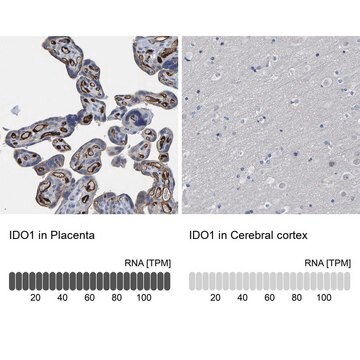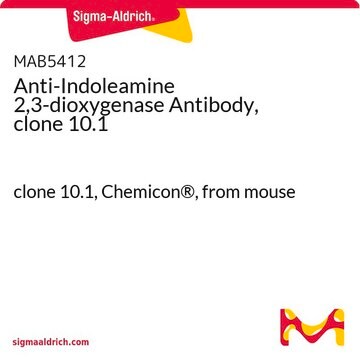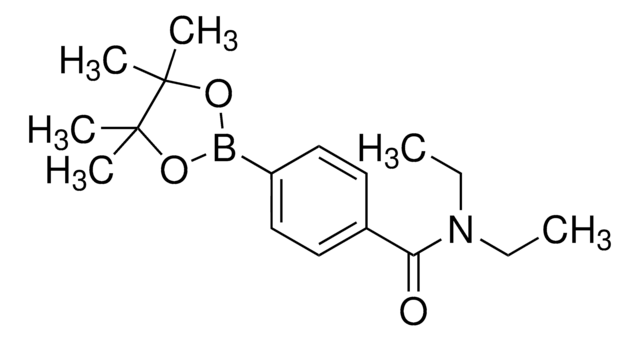おすすめの製品
由来生物
mouse
品質水準
抗体製品の状態
purified immunoglobulin
抗体製品タイプ
primary antibodies
クローン
4B7, monoclonal
化学種の反応性
mouse, rat
テクニック
immunohistochemistry: suitable (paraffin)
western blot: suitable
アイソタイプ
IgG1κ
NCBIアクセッション番号
UniProtアクセッション番号
輸送温度
wet ice
ターゲットの翻訳後修飾
unmodified
遺伝子情報
mouse ... Ido1(15930)
詳細
Indoleamine 2,3-dioxygenase 1 (EC 1.13.11.52; UniProt P28776; also known as IDO-1, indole 2,3-dioxygenase, Indoleamine-pyrrole 2,3-dioxygenase) is encoded by the Ido1 (also known as Ido, Indo) gene (Gene ID 15930) in murine species. Indoleamine 2,3-dioxygenase-1 (IDO1) is a heme containing enzyme that catalyzes the rate-limiting step in tryptophan catabolism to N-formyl-kynurenine. The reduction in local tryptophan and the upregulated immunomodulatory tryptophan metabolites form the basis of IDO-dependent regulation of inflammation and immunity. IDO is reported to support carcinogenesis by modulating tissue microenvironment inflammatory responses. IDO is also reported to mediate immune escape in cancer by suppressing the function of T effector cells and promote the differentiation of T regulatory cells.
特異性
Target specificity of clone 4B7 has been confirmed by both immunohistochemistry and Western blotting using tissue samples from wild-type and Ido1-knockout mice (Thomas, S., et al. (2014). J. Cell. Biochem. 115(2):391-396).
免疫原
KLH-conjugated linear peptide corresponding to the N-terminal region of mouse IDO-1.
アプリケーション
Immunohistochemistry Analysis: A 1:50 dilution from a representative lot detected IDO-1 in rat kidney tissue.
Immunohistochemistry Analysis: A representative lot detected IDO-1 immunoreactivity in acetone-fixed frozen colon tissue sections from wild-type, but not Ido1-knockout mice (Courtesy of Dr. Sunil Thomas, Lankenau Institute for Medical Research, Wynnewood, PA).
Immunofluorescence Analysis: A representative lot detected IDO-1 immunoreactivity in acetone-fixed frozen colon and epididymis tissue sections from wild-type, but not Ido1-knockout mice by fluorescent immunohistochemistry (Courtesy of Dr. Sunil Thomas, Lankenau Institute for Medical Research, Wynnewood, PA).
Western Blotting Analysis: A representative lot detected IDO-1 in epididymis and colon tissue extracts from wild-type, but not Ido1-knockout mice (Thomas, S., et al. (2014). J. Cell. Biochem. 115(2):391-396).
Immunohistochemistry Analysis: A representative lot detected IDO-1 immunoreactivity in multiple acetone-fixed frozen tissue sections from wild-type, but not Ido1-knockout mice, including epididymis, colon, heart, liver, and 4T1-metastasized lung tissue sections (Thomas, S., et al. (2014). J. Cell. Biochem. 115(2):391-396).
Immunohistochemistry Analysis: A representative lot detected IDO-1 immunoreactivity in acetone-fixed frozen colon tissue sections from wild-type, but not Ido1-knockout mice (Courtesy of Dr. Sunil Thomas, Lankenau Institute for Medical Research, Wynnewood, PA).
Immunofluorescence Analysis: A representative lot detected IDO-1 immunoreactivity in acetone-fixed frozen colon and epididymis tissue sections from wild-type, but not Ido1-knockout mice by fluorescent immunohistochemistry (Courtesy of Dr. Sunil Thomas, Lankenau Institute for Medical Research, Wynnewood, PA).
Western Blotting Analysis: A representative lot detected IDO-1 in epididymis and colon tissue extracts from wild-type, but not Ido1-knockout mice (Thomas, S., et al. (2014). J. Cell. Biochem. 115(2):391-396).
Immunohistochemistry Analysis: A representative lot detected IDO-1 immunoreactivity in multiple acetone-fixed frozen tissue sections from wild-type, but not Ido1-knockout mice, including epididymis, colon, heart, liver, and 4T1-metastasized lung tissue sections (Thomas, S., et al. (2014). J. Cell. Biochem. 115(2):391-396).
This Anti-IDO-1 Antibody, clone 4B7 | MABF850 is validated for use in Immunohistochemistry (Paraffin), Western Blotting for the detection of IDO-1.
品質
Evaluated by Immunohistochemistry in mouse kidney tissue.
Immunohistochemistry Analysis: A 1:50 dilution of this antibody detected IDO-1 in mouse kidney tissue.
Immunohistochemistry Analysis: A 1:50 dilution of this antibody detected IDO-1 in mouse kidney tissue.
ターゲットの説明
~45 kDa calculated
物理的形状
Format: Purified
その他情報
Concentration: Please refer to lot specific datasheet.
Not finding the right product?
Try our 製品選択ツール.
保管分類コード
12 - Non Combustible Liquids
WGK
WGK 1
引火点(°F)
Not applicable
引火点(℃)
Not applicable
適用法令
試験研究用途を考慮した関連法令を主に挙げております。化学物質以外については、一部の情報のみ提供しています。 製品を安全かつ合法的に使用することは、使用者の義務です。最新情報により修正される場合があります。WEBの反映には時間を要することがあるため、適宜SDSをご参照ください。
Jan Code
MABF850:
試験成績書(COA)
製品のロット番号・バッチ番号を入力して、試験成績書(COA) を検索できます。ロット番号・バッチ番号は、製品ラベルに「Lot」または「Batch」に続いて記載されています。
Souvik Dey et al.
Journal for immunotherapy of cancer, 8(2) (2020-07-22)
The tryptophan-catabolizing enzyme indoleamine 2,3-dioxygenase 1 (IDO1), which subverts T-cell immunity at multiple levels, is itself subject to inherent T-cell reactivity. This intriguing deviation from central tolerance has been interpreted as counterbalancing IDO1-mediated immunosuppression. Based on this hypothesis, clinical studies
Yahya Jand et al.
Scientific reports, 12(1), 15963-15963 (2022-09-25)
Melatonin (MT), a neurohormone with immunomodulatory properties, is one of the metabolites produced in the brain from tryptophan (TRP) that has already strong links with the neuropathogenesis of Multiple sclerosis (MS). However, the exact molecular mechanisms behind that are not
Willy Jaya Suento et al.
Journal of neurochemistry, 157(6), 1963-1978 (2020-10-24)
Indoleamine 2,3-dioxygenase 1 (IDO1) is the first rate-limiting enzyme that metabolizes tryptophan to the kynurenine pathway. Its activity is highly inducible by pro-inflammatory cytokines and correlates with the severity of major depressive disorder (MDD). MicroRNAs (miRNAs) are involved in gene
Tatsuya Ando et al.
Molecular medicine reports, 27(2) (2022-12-10)
The partial loss of liver due to liver transplantation or acute liver failure induces rapid liver regeneration. Recently, we reported that the selective inhibition of indoleamine 2,3‑dioxygenase (Ido) 1 promotes early liver regeneration. However, the role of Ido2 in liver
Yuying Liu et al.
Nature communications, 8, 15207-15207 (2017-05-11)
Interactions with the immune system may lead tumorigenic cells into dormancy. However, the underlying molecular mechanism is poorly understood. Using a 3D fibrin gel model, we show that IFN-γ induces tumour-repopulating cells (TRCs) to enter dormancy through an indolamine 2,3-dioxygenase
ライフサイエンス、有機合成、材料科学、クロマトグラフィー、分析など、あらゆる分野の研究に経験のあるメンバーがおります。.
製品に関するお問い合わせはこちら(テクニカルサービス)








